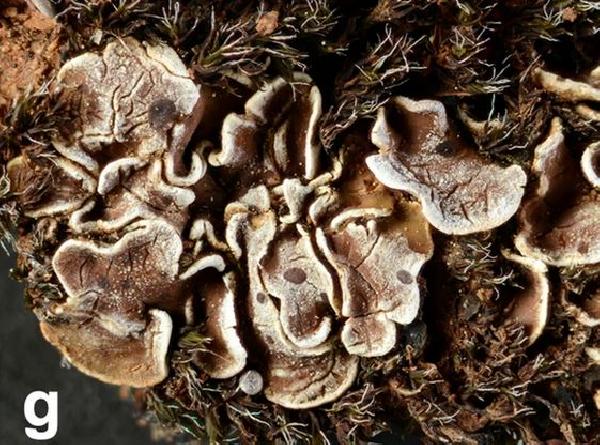Psora taurensis Timdal, Bendiksby, A.M. Kahraman & Halıcı
MycoKeys, 21: 9, 2017.
Synonyms:
Distribution:
Description: Thallus squamulose, the squamules up to 8 mm wide, rounded, adnate with ascending margins to imbricate, finally deeply lobed, concave, the upper surface medium brown, dull, fissured, the margins at first concolorous with upper side, but soon turning white-pruinose, often somewhat up-turned; lower surface white to pale brown, attached by rhizohyphae. Upper cortex up to 130 µm thick, including an up to 20 µm thick epinecral layer, of thick-walled hyphae with angular to rounded lumina, not containing crystals; medulla not amyloid, with crystals; lower cortex poorly developed. Apothecia biatorine, up to 1.5 mm across, laminal or submarginal, brownish black, epruinose, weakly convex and indistinctly marginate when young, soon turning strongly convex and immarginate. Proper exciple yellowish brown in outer part, colourless within, lacking crystals, of radiating, thick-walled hyphae; epithecium yellowish brown, containing orange crystals dissolving in K, K+ purple; hymenium colourless, amyloid, 70-90 μm high; paraphyses thin-walled, moderately coherent, sparingly branched and anastomosing, with a slightly swollen apical cell; hypothecium colourless in lower part, pale brown in upper part, with crystals of calcium oxalate. Asci 8-spored, elongate-clavate, with a thin, outer amyloid layer and a thickened tholus penetrated by a tube, the sides of which stain I/KI+ deep blue, without an ocular chamber, Porpidia-type. Ascospores 1-celled, hyaline, ellipsoid, 11-16 x 5.5-7 µm. Photobiont chlorococcoid. Spot tests: medulla K+ yellow turning red, C-, KC-, P+ orange. Chemistry: medulla with norstictic acid; apothecia with anthraquinones.Note: a recently-described species known from a few localities in Turkey and Spain, growing on calciferous soil. For further details see Timdal & al. (2017). To be looked for in Mediterranean Italy.
Growth form: Squamulose
Substrata: soil, terricolous mosses, and plant debris
Photobiont: green algae other than Trentepohlia
Reproductive strategy: mainly sexual

Predictive model

Source: Evankow, A.M., Yin, A., Zulfiqar, R. et al. Psora mediterranea (Lecanorales, Psoraceae), a new lichen species from Europe, including a new concept for P. himalayana and a revised key to the European species. Mycol Progress 24, 26 (2025). https://doi.org/10.1007/s11557-025-02045-8 - CC BY 4.0
Turkey, paratype: O-L-203076, Photo: E. Timdal
Growth form: Squamulose
Substrata: soil, terricolous mosses, and plant debris
Photobiont: green algae other than Trentepohlia
Reproductive strategy: mainly sexual

Predictive model



